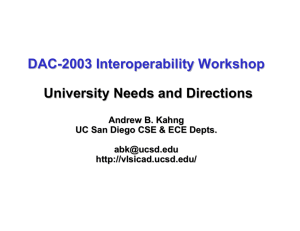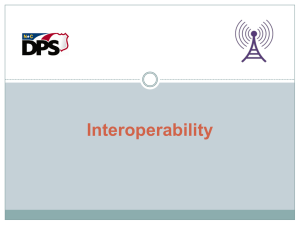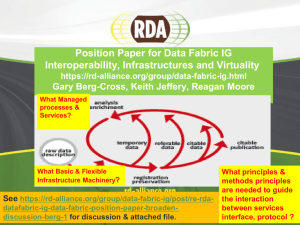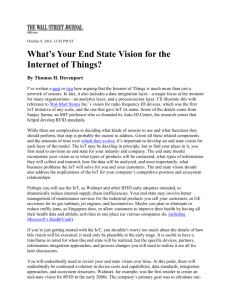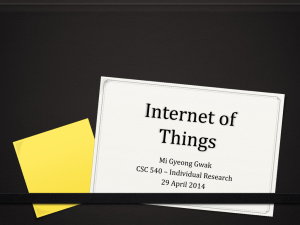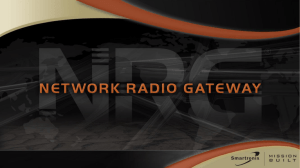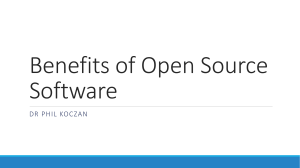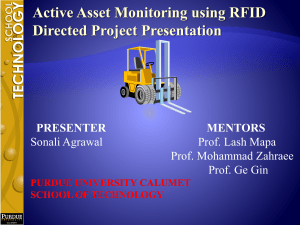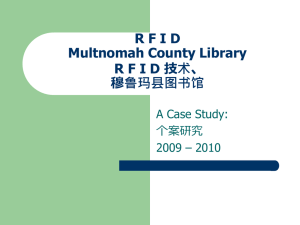Internet of Things
advertisement
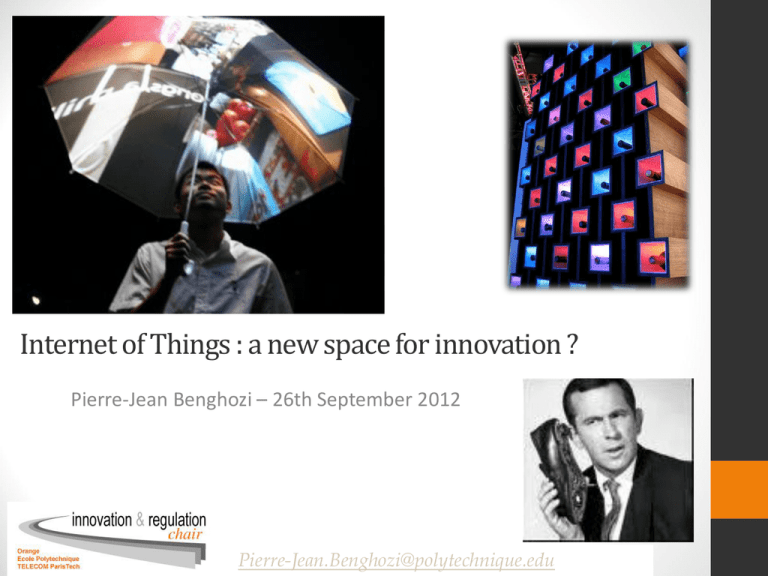
Internet of Things : a new space for innovation ? Pierre-Jean Benghozi – 26th September 2012 Pierre-Jean.Benghozi@polytechnique.edu Introduction 2 Let’s remind the main arguments and hypothesis regarding innovation • Specificity and centrality of innovation processes call for : • Global design of market and organisation • Rather than • • • • Upstream / downstream push / pull sequential and linear sectorial and layer oriented • Diversity of innovative resources and assets • Control of creative resources and market design • Rather than business strategy, competition & market price • New means for regulation and public policies • Yet to keep in mind • The key role of technology • To provide new products and services • To support « new » creative processes 3 Some questions are specifically addressed to [by] the internet • An unlike wave of (generic) technology • a web folio combination of various components • a large range of functionalities • Flexible technologies supporting various projects • Generating certainties and doubts • Economic or technical lever ? • Evolution or digital revolution 4 Distinctiveness of innovative processes in the internet • An unlike wave of (generic) technology • a combination of various components and functionalities • Flexible technologies supporting various projects • New economic and organisational designs • Conceiving Business model + uses + applications + technology • Restructuring the value chains • Competition from outside ICT sectors and from various layers • Acceleration and globality of the conception process • Various paces of innovation to master • Valuating new set of resources • Generating certainties and doubts • Economic or technical lever ? • Evolution or digital revolution • Some questions to be specially addressed 5 Some consequences • Innovation viewpoint might be overlighted • Traditional innovation models undermined by digitisation • Individual creator dissolves in collective conception • Transformation of the value chain • • • • Growing role of distribution and Reversing cost structure Brand dominance Infomediation Logistics • Structuring and diversifying business models • Valuating new technical devices, communities of users • Cross subsidization and importance of ancillary markets 6 A situation emphasized in/by the internet of things (IoT) Definiton How to Define the Iot? • Formally : a network of networks which enables to identify digital entities and physical objects • whether they are inanimate (including plants) or animate (animals and human beings) – directly and without ambiguity, via standardized electronic identification systems and wireless mobile devices, and thus make it possible to retrieve, store, transfer and process data relating to them, without discontinuity between the physical and virtual worlds” (Benghozi, Bureau, Massit-Folléa, 2008) • Conceptually : new identities for objects • “Things having identities and virtual personalities operating in smart spaces using intelligent interfaces to connect and communicate within social, environmental, and user contexts” (working group Eposs) • Technically : an extension of the Internet • naming system and reveals a convergence of digital identifiers in the sense that it is possible to identify digital information (URL website addresses for instance) and physical elements (like a pallet in a warehouse, or a sheep in a herd) in a standardized way • From the user point: a new space for innovative services 8 IoT = the future of the internet ? • R&D programs all over the world • Europe (ambiant intelligence), Japon (ubiquituous computing) China… • Complementary technological paths : • Convergence and discontinuities : 1.0 ≈ 2.0 ≈ 3.0 • From bar code to multiple electronic identification devices • From early B2B to massive applications (animals, health…) • Major socio-technico-economic trends • • • • • From product to services From fixed to mobile technologies Physical and virtual worlds Complex and unstable technological choices and standards Attractive technologies : but unknown and badly accepted • Conflicting visions and various questions at stake : • • • • consistency, sustainability and (low) cost Portfolio of technologies, networks and applications Incentive and support for innovation for economic growth To implement pervasive but non intrusive systems 9 IoT a support for various dreams • • • • • Perfect identification – traceability New Big Brother Cost killing applications Improve quality, reduce errors A tag as usuals • Extension of traditional Bar code 10 Rather : a network of converging networks Internet : IPv6 GPS Mobility Data matrix ONS Sensors RFID, tags & readers ad hoc networks 11 Id est = a system of systems Type of system Stakes Identification Sensors Integration Identifying each Data Networks processing (incl. readers) object in a Collecting Connecting Integrating Storing and information in systems between systems for data analysing data to unique way and the environment Old Connection retrieving data to enrich the stored in the functionalities of object the systems Barcodes, simple Thermometer themselves Cables, … Transferring data to and from to be transmitted launch a process physical and from one layer to or ease decision- virtual worlds another making Middleware… Excel, ERP, CRM… Internet, RFID solutions hydrometer… Recent Complex RFID Miniature Bluetooth, Complex Datawarehouse 3D EPCglobal technologies solutions, sensors, Near Field middleware (compatible with network… technologies Ethernet… (examples) (examples) Surface Acoustic nanotechnologies Waves, optical chips, AND Communication, RFID chips), WiFi... Semantic Web … 12 Supporting a large range of applications 13 Creating space for innovative apps 14 Innovation fostered by interoperability • Interoperability is a crucial building block • • • • increasing variety of applications enabling emergence of niche-markets (long-tail) articulating standard technical interfaces and P2P allowing convergence of distinct systems in the open ecosystem of IoT, • Interoperability reduces access barriers • to digital content • to a great variety of innovative services of any kind • Interoperability enhances user autonomy • increases creativity and freedom of stakeholders and actors in the field • widen the range of choice for consumer 15 Conclusion : Drivers and uncertainties 16 Remain on the phone, I think I even took a picture of my ear The technical side • Competing technical solutions • Different types of RFID • Alternatives solutions to RFID • The main technological needs • • • • Guaranteeing the performance of solutions in use contexts Ensuring the durability of solutions Conceiving an efficient data management system Some specific bottlenecks (memory, privacy…) • The standardization and interoperability = a key dimension • Dependence on existing standards. • A standard of standards. • Standards “granularity” and interoperability 17 The business perspective What performance? – Local contexts (quality, prices…) – Macro effects Who should invest and why? – Traditional firms vs new entrants – ROI New Business Models – Redefinition of the value chains – New services for consumers – New resources for efficiency The supply side – Which market ? – Which suppliers ? 18 The usability viewpoint 19 Diffusion uncertainties : privacy, the mostly mentionned risk Multifaceted risk – Traditional + emerging – Personal + industrial – Technical + process questions Efficiciency vs. Privacy Multiple identities, regulation A market for security and Privacy Enhancing Technologies 20 Yet startling risks 21 Startling risks • M2M risks and liability • • • • Environment Falsification Logarithmic conflicts Trust in informations • Ethical concerns • From things to animal and individual tagging • awareness and education • Freedom of silence, withdrawing and forgetfulness 22 Consequence : a second hand creativity society ? • Evidence for innovations • The rising of interoperability, mashups and UGC • Incentives to innovate on the level playing field • Interoperability leads to increased competition • reduction of lock-in effects and market entry barriers • leads to more innovation on services rather than technology ? • Impact on radical innovation unclear • Interoperability does not always lead to innovation • May be destructive in some cases 23 Public policies and governance at stake Industrial regulation and innovation – Industrial policy and incentives for R&D + implementation – Competition policy Technical governance Governance of network infrastructure – The net neutrality Regulatory frameworks – Firms – Consumers and citizens – Standardization of data 24 Thanks for your attention

